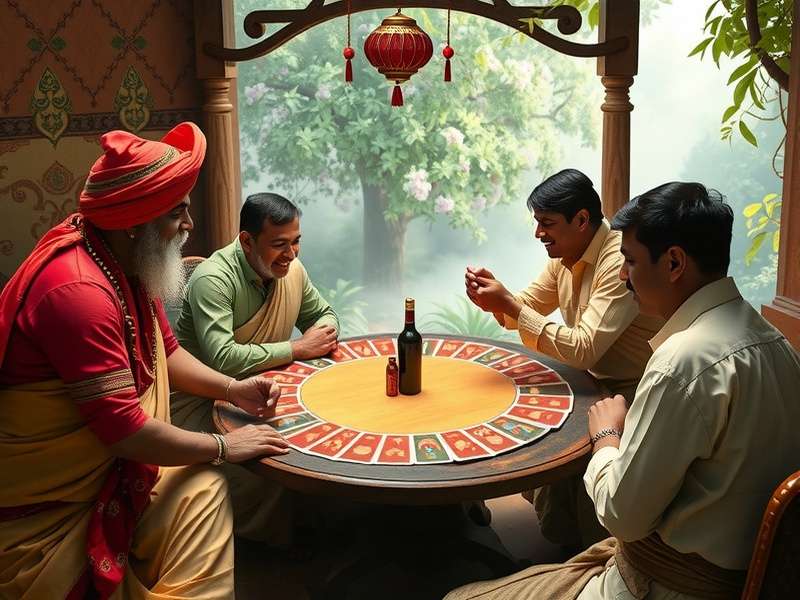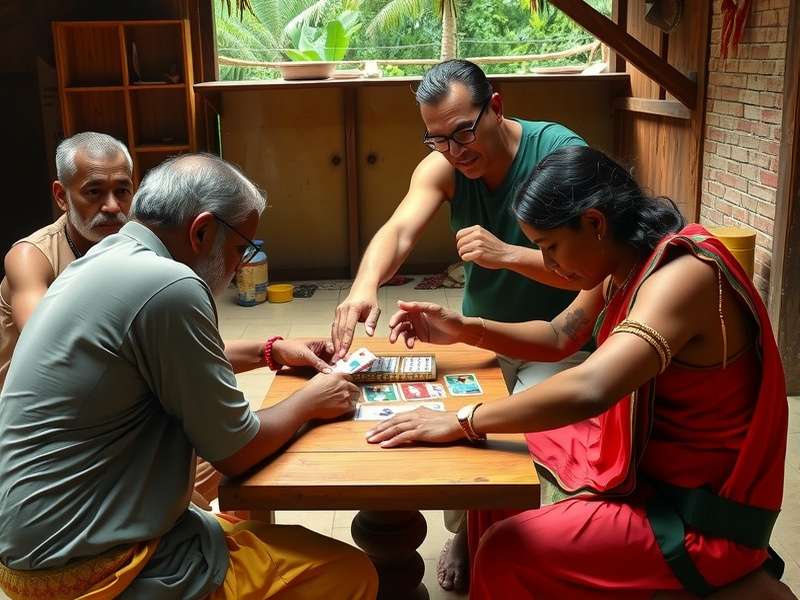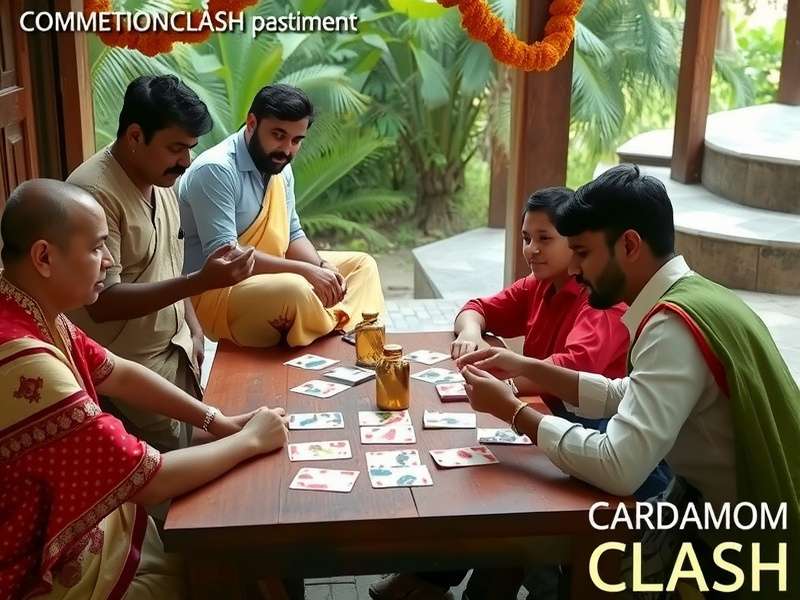Cardamom Clash: The Ultimate Indian Card Game 🃏
Discover the rich history, intricate rules, and winning strategies of India's most beloved traditional card game
Table of Contents

Overview of Cardamom Clash 🌟
Cardamom Clashrepresents one of India's most cherished traditional card games, blending strategic depth with cultural heritage. This engaging game has captivated players across generations with its unique mechanics and competitive spirit.
Key Fact:The nameCardamom Clashderives from the game's historical association with spice trading communities in Kerala, where cardamom was a valuable commodity.
Unlike Western card games,Cardamom Clashincorporates elements of Indian numerology and traditional storytelling. Players must master both tactical card play and psychological warfare to emerge victorious.
The game typically accommodates 2-6 players and utilizes a modified 52-card deck with special regional suits. Each match unfolds as a dramatic narrative, with fortunes shifting rapidly between participants.
Strategic Depth
Combines elements of memory, probability calculation, and bluffing for a multifaceted challenge.
Social Interaction
Fosters lively conversation and bonding between players of all ages and backgrounds.
Historical Origins & Evolution 📜
The origins ofCardamom Clashtrace back to 16th century South India, specifically the Malabar Coast region known for its vibrant spice trade. Historical records suggest the game evolved from earlier gambling pastimes played by merchants during monsoon seasons.
British colonial accounts from the 18th century document variations of the game being played in Madras and Calcutta. These early versions featured different scoring systems and card designs that reflected regional preferences and available materials.
- 1550-1600:Earliest documented references to spice merchant card games
- 1750:Standardization of rules across trading communities
- 1850:Introduction of the game to aristocratic circles
- 1920:First printed rulebooks distributed regionally
- 1975:National tournament circuit established
- 2005:Digital adaptations begin appearing online
Throughout its development,Cardamom Clashabsorbed influences from various cultural traditions. Persian card games introduced during Mughal rule contributed to the scoring system, while Portuguese traders brought European deck designs that influenced card artwork.
The game's modern form crystallized in the early 20th century when regional tournaments began standardizing rules. This period saw the establishment of the distinctive bidding and trick-taking mechanics that define contemporaryCardamom Clashgameplay.

Complete Game Rules & Setup 🎯
MasteringCardamom Clashrequires understanding its unique rule structure. The game combines elements of trick-taking, set collection, and strategic bidding in a distinctive fusion.
Equipment Requirements
A standardCardamom Clashset includes a modified 52-card deck with traditional Indian suits: Gada (mace), Kamal (lotus), Talwar (sword), and Mohra (coin). Each suit contains cards numbered 1-10 plus three court cards: Mantri (minister), Senapati (commander), and Raja (king).
Game Setup
Players begin by drawing for deal. The dealer shuffles thoroughly and distributes 8 cards to each player in clockwise fashion. The remaining cards form the draw pile, with the top card revealed to determine trump suit for the initial round.
- Bidding Phase:Players bid on how many tricks they expect to win
- Card Play:Players follow suit or play trump cards to win tricks
- Scoring:Points awarded for successful bids and special combinations
- Round Conclusion:Scores tallied and new round begins with different dealer
Advanced Rules
Experienced players utilize special moves like "Spice Trade" (exchanging unwanted cards), "Monsoon" (forcing all players to draw additional cards), and "Elephant Charge" (playing multiple cards of same rank simultaneously).
Scoring inCardamom Clashincorporates both trick points and combination bonuses. Successful bids earn base points, while special card arrangements like "Royal Spice" (all court cards of one suit) or "Merchant's Fortune" (sequential cards across suits) provide substantial bonuses.
Advanced Playing Strategies 🧠
Elevating yourCardamom Clashperformance requires mastering both fundamental tactics and advanced psychological plays. Successful players balance mathematical probability with reading opponent behavior.
Bidding Strategies
Conservative bidding focuses on securing easily achievable targets, while aggressive bidding risks higher rewards. Expert players analyze their hand strength, remaining trump cards, and opponent tendencies before committing to a bid.
Pro Tip:Track which high-value cards have been played to accurately assess trick-winning potential in later rounds. Memory forms a crucial component of advancedCardamom Clashstrategy.
Card Management
Preserving trump cards for critical moments often proves more valuable than winning early tricks. Similarly, holding onto potential combination cards until scoring opportunities arise can dramatically increase point yields.
Psychological Warfare
Bluffing represents a core element of high-level play. Deliberately underbidding with strong hands or overbidding with weak ones can mislead opponents about your intentions and card holdings.
Observing opponent patterns provides valuable information. Players who consistently follow certain bidding or playing styles become predictable, creating exploitation opportunities for attentive competitors.

Regional Variations 🌍
AsCardamom Clashspread across the Indian subcontinent, regional communities developed distinctive variations reflecting local cultures and preferences. These versions maintain the core gameplay while introducing unique twists.
Kerala Spice Rules
The original Malabar Coast variation features extended bidding rounds and additional spice-themed card combinations. This version places greater emphasis on memory and probability calculation than other regional forms.
Punjabi Power Play
Northern variations incorporate faster gameplay with reduced hand sizes and more aggressive scoring opportunities. The Punjabi version famously includes the "Bhangra" move allowing players to steal tricks under specific conditions.
Bengali Renaissance Rules
Eastern adaptations focus on artistic card designs and elaborate combination scoring. The Bengali version introduces poetry-inspired card arrangements that award bonus points for aesthetically pleasing plays.
Tamil Temple Rules
Southern variations incorporate temple architecture themes with special "Gopuram" combinations that multiply scores. This version features the most complex bidding system of all regional variations.
Cultural Significance & Impact 🕌
Cardamom Clashtranscends mere entertainment, occupying an important place in Indian social and cultural traditions. The game features prominently in festivals, family gatherings, and community events across the country.
During Diwali celebrations, families often play special "Festival Rules" versions ofCardamom Clashwith modified scoring that incorporates traditional elements of the holiday. Similarly, wedding celebrations frequently include friendly tournaments among guests.
- Family Bonding:Multi-generational gameplay strengthens family ties
- Mathematical Education:Children develop calculation skills through play
- Social Harmony:Games bridge community divides across class and background
- Cultural Preservation:Traditional artwork and themes maintained through cards
The game has inspired various artistic expressions including folk songs, short stories, and even Bollywood film sequences. Several contemporary Indian authors have referencedCardamom Clashas metaphor for political or romantic intrigue in their works.
Academic researchers have studied the game's influence on cognitive development, particularly regarding pattern recognition and strategic thinking. Some educational institutions have incorporatedCardamom Clashinto mathematics curricula to demonstrate probability concepts.
Modern Adaptations & Digital Versions 💻
In the 21st century,Cardamom Clashhas successfully transitioned to digital platforms while maintaining its traditional appeal. Mobile applications and online platforms have introduced the game to international audiences.
Digital Implementations
Several software companies have developed licensed digital versions ofCardamom Clashwith features like tutorial modes, AI opponents of varying difficulty, and online multiplayer matchmaking. These adaptations preserve the core gameplay while adding quality-of-life improvements.
Competitive Scene
The national tournament circuit has expanded to include both physical and digital competitions. Major cities host annualCardamom Clashchampionships that attract hundreds of participants and substantial prize pools.
Future Outlook:Developers are exploring augmented reality implementations that would overlay digital card displays onto physical surfaces, blending traditional and modern gameplay experiences.
Educational Applications
Several educational institutions have incorporatedCardamom Clashinto their curricula to teach strategic thinking, probability, and cultural studies. Research indicates that students who learn through game-based approaches show improved retention and engagement.
The enduring popularity ofCardamom Clashacross centuries demonstrates the timeless appeal of well-designed games that balance skill and chance while fostering social connection. As new generations discover this classic, its legacy continues to evolve while honoring its rich cultural heritage.
Cardamom Clash Quick Reference
Players
2-6
Game Duration
30-90 mins
Complexity
Medium-High
Age
10+